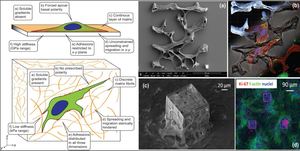Three‐dimensional patterning in biomedicine: Importance and applications in neuropharmacology
2017
Article
pi
Abstract Nature manufactures biological systems in three dimensions with precisely controlled spatiotemporal profiles on hierarchical length and time scales. In this article, we review 3D patterning of biological systems on synthetic platforms for neuropharmacological applications. We briefly describe 3D versus 2D chemical and topographical patterning methods and their limitations. Subsequently, an overview of introducing a third dimension in neuropharmacological research with delineation of chemical and topographical roles is presented. Finally, toward the end of this article, an explanation of how 3D patterning has played a pivotal role in relevant fields of neuropharmacology to understand neurophysiology during development, normal health, and disease conditions is described. The future prospects of organs‐on‐a‐‐like devices to mimic patterned blood–brain barrier in the context of neurotherapeutic discovery and development for the prioritization of lead candidates, membrane potential, and toxicity testing are also described. © 2017 Wiley Periodicals, Inc. J Biomed Mater Res Part B: Appl Biomater, 106B: 1369–1382, 2018.
| Author(s): | Ajay Vikram Singh, Tanmay Gharat, Madu Batuwangala, Byung-Wook Park, Thomas Endlein, Metin Sitti |
| Journal: | Journal of Biomedical Materials Research Part B: Applied Biomaterials |
| Volume: | 106 |
| Number (issue): | 3 |
| Pages: | 1369-1382 |
| Year: | 2017 |
| Department(s): | Physical Intelligence |
| Bibtex Type: | Article (article) |
| DOI: | 10.1002/jbm.b.33922 |
|
BibTex @article{doi:10.1002/jbm.b.33922,
title = {Three‐dimensional patterning in biomedicine: Importance and applications in neuropharmacology},
author = {},
journal = {Journal of Biomedical Materials Research Part B: Applied Biomaterials},
volume = {106},
number = {3},
pages = {1369-1382},
year = {2017},
doi = {10.1002/jbm.b.33922}
}
|
|





